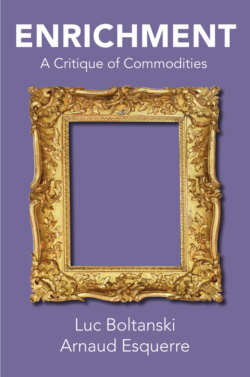Читать книгу Enrichment - Luc Boltanski - Страница 25
An economic reorientation toward the wealthy
ОглавлениеAs the foregoing observations suggest, the formation of an economic sphere of enrichment, often described in terms of comparative advantages, has been marked by a phenomenon particularly obvious in France but apparent in Western economies more generally: a reorientation toward offering goods capable of satisfying the demands of wealthy or ultra-wealthy clients throughout the world. The number of such people has risen considerably over the last twenty years. They are based chiefly in countries such as France and the United States, where huge fortunes transmitted by inheritance were already well established and where the increase in wealth has been particularly spectacular at the top of the income scale. But the number of wealthy and ultra-wealthy persons is also growing in emerging countries, where those with fortunes have either benefited from financial operations or taken advantage of the profits generated by industrialization in countries with cheap labor. In other words, the increase in the small number of wealthy and extremely wealthy people has accompanied the increase in inequality worldwide.
The bottom line of private financial fortunes (savings in bank accounts, financial instruments, or life insurance policies) does not represent the totality of accumulated fortunes, most notably because it does not include holdings in the form of material goods, including real estate. But since these latter goods are more difficult to identify and evaluate, the increase in the monetary total of fortunes can serve as an indicator allowing us to estimate private fortunes and the rise in inequalities on a global scale. As it happens, the total amount of money in financial fortunes increased by 14.6 percent in 2013. The wealthiest zones are the United States (50 trillion dollars) and Western Europe (38 trillion), followed by the Asian Pacific countries (37 trillion). The growth in private fortunes has kept pace with the growing number of millionaires (in American dollars), which went from 13.7 million in 2012 to 16.3 million in 2013. These millionaires, who represent 1.1 percent of households, are concentrated primarily in the United States (7.1 million households, which possess 63 percent of the private fortunes in America); their number has also gone up in China, reaching 2.4 million. The density of these millionaires in relation to the total number of households as permanent residents is highest in Qatar, Switzerland, and Singapore. In 2015, the number of millionaires continued to grow (by 6 percent), reaching a total of 18.5 million. This 1 percent holds 47 percent of the world’s financial wealth. Some portion of these private fortunes is held in offshore banks, whose holdings reached 8.9 trillion in 2013, an increase of 10.4 percent over the previous year. They are estimated to correspond to between 8 and 11 percent of the financial patrimony of households, and they were expected to reach 12.4 trillion in 2018. The most important offshore banks are in Switzerland, followed by Singapore and Hong Kong. In France, tax evasion probably totaled 17 billion euros in 2013.97
The economic reorientation of Western countries toward the wealthy has marked a break with the type of growth that had characterized the postwar decades. We can measure the scale of the change if we recall that postwar growth was driven by national production of standardized goods whose distribution, aimed at first toward the upper middle class, was later extended to the middle classes, and even to the lower classes in the case of goods such as household appliances and cars. This seemed to confirm the idea that enrichment of the elites would inevitably benefit even the destitute in the end (the trickle-down process). Often described at the time in terms of “democratization,” this economy was supposed to profit from an increase in buying power on the part of the most disadvantaged, a change to be stimulated by the redistribution of a portion of the benefits generated by increased productivity, as economists of the “regulation school” demonstrated.
One effect of this economic reorientation has been an intensification of the two-track consumption pattern, with a growing contrast between mass consumption of standardized products sold by companies with a wide distribution network to the least wealthy buyers, on the one hand, and consumption of products that are defined precisely in opposition to standardized objects and are intended to satisfy the needs of wealthier buyers, on the other hand.98 These latter products are exemplified in the realm of food by items presented as artisanal or organic and guaranteed by a brand name or, in other realms, by personal objects (knives, for instance) presumed to have been made according to ancestral practices, with traces of the makers on display. Such products are typically guaranteed by an assertion that the items have not been produced in a series of assembly lines operated by countless anonymous workers but, rather, that they have been handcrafted by a single individual who “made them with love.”
By contrast with mass production, which was legitimized in democratic terms, the enrichment economy aims to exploit the buying power of those who can afford exceptional goods. This is why the comparison between the wealthy and the rest allows us to understand the dynamics of the enrichment economy better than we would by referring specifically to social classes differentiated by their income levels and by what they can leave their heirs; the categories of rich and poor function in a relative logic of opposition rather than as categories with clear boundaries. While the enrichment economy is addressed first of all to the rich and the very rich, it has the peculiar feature of addressing the others too, as if they were rich, or, at the very least, richer than they are.
